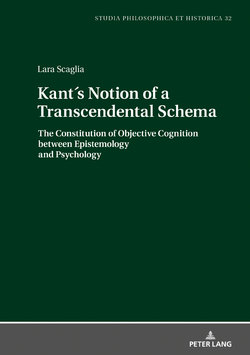Читать книгу Kant´s Notion of a Transcendental Schema - Lara Scaglia - Страница 10
На сайте Литреса книга снята с продажи.
ОглавлениеContents
Introduction
Main objectives of the study
Method
State of the art
Structure
Part I: Kant’s theory of schematism and its context
1. The notion of schema before Kant
1.1Ancient times
1.2Middle Ages
1.3Modern Ages
1.3.1Tetens’s conception of schema
1.4Conclusion
2. Kant’s pre-critical notion of schema
2.1The metaphysical notion of schema in the Nova Dilucidatio
2.2The new significance of schema in the Dissertation from 1770. A first reference to the problem of objectivity
2.2.1Schema and the forms of the worlds
2.2.2The novelty of the account of space and time as schemata in the Dissertation: Comparison with Newton and Leibniz
2.2.3The limitations of Kant’s Dissertation and the need of a further solution to the question of objectivity
3. The introduction of the transcendental forms in the Critique of Pure Reason
3.1The doctrine of sensibility
3.2The doctrine of the understanding
4. Analysis of the schematism chapter
4.1The Transcendental Doctrine of Judgement
4.2Time-mediation
4.3Schemata and their faculty
4.4Schemata: images or concepts?
4.5The table of schemata
4.6Schemata as conditions of the significance of the pure concepts
5. Debates over the schematism chapter in Kantian scholarship
5.1Main criticisms of the schematism chapter
5.1.1A redundant addition within the Critique of Pure Reason
a)Zschocke’s focus on the Transcendental Aesthetic
b)Curtius: the schematism chapter and § 24
5.1.2Schematism’s obscure terminology
a)Curtius: difficulties concerning the notion of subsumption
b)Walsh: schemata and concepts
c)Guyer: incongruences in the relation between categories and schemata
d)Allison: difficulties concerning the distinctions among faculties and the variety of schemata’s definitions
5.1.3The priority ascribed to time over space
a)Zschocke’s criticism of time as being the only mediating function
b)Walsh’s introduction of “organic” schemata
c)Guyer: Schemata and temporality
5.2In response to the criticisms of the schematism chapter
5.2.1The necessity of schematism in the Critique of Pure Reason
a)The distinction between the function of the Transcendental Deduction and the task of the schematism chapter
b)“Knowing that and knowing how”
5.2.2The obscurity of the chapter
a)Subsumption
b)“To be” and “to do”: defining schemata
c)The distinction between categories and forms of intuition
d)Categories and schemata
e)Schemata and principles
f)Schemata and ideas
g)Judgement and its role between reason and understanding
5.2.3Space and time
a)Time, at least
b)Dynamic schemata
c)Difficulties within Kant’s text
Part II: After Kant
1. The philosophical reception and criticism of the schematism chapter
1.1The earliest receptions of Kant’s schematism chapter
1.2Idealism and post-Kantianism
1.3From the late nineteenth to the early twentieth century
2. Kant’s distinction between philosophy and psychology
2.1Philosophy as a system of concepts
2.2Psychology: a doctrine of the inner sense
2.3Is Kant a transcendental psychologist?
3. Kant’s notion of a schema in twentieth-century psychology
3.1Schema theories
3.2Frederic Bartlett
3.2.1A pioneer of applied psychology
3.2.2Experimental method
3.2.3The topics of experiments
3.2.4Remembering
3.2.5Schematic settings
3.2.6Meaning
3.2.7Conclusion
3.3Jean Piaget’s interpretation of Kant’s notion of a schema
3.3.1An interest in both theoretical and empirical studies
3.3.2A “philosophical shock”
3.3.3Piaget’s notion of schemata
3.3.4An example of a schema: the object
3.3.5Experience as an organisation through schemata. Piaget’s perspective between empiricism and apriorism
3.3.6Piaget’s novelty and difference from Kant’s view
3.4Lawrence Barsalou’s reception of Kant’s transcendental schematism
3.4.1Cognitive psychology
3.4.2Categorisation
3.4.3Modal theory versus amodal theory
3.4.4Properties
a)Neural representations
b)Schematic perceptual symbols
c)Multimodal symbols
d)Simulators
e)Frames
f)Linguistic indexing and control
3.4.5Barsalou and Kant
3.4.6Psychology and philosophy
Conclusion
Schema: the history of an idea
The function of schematism
Schematisms’s legacy between philosophy and psychology
New perspectives
Bibliography
Lists of abbreviations for classical works
Primary literature
Secondary literature
Online resources
List of figures
List of tables
Index
